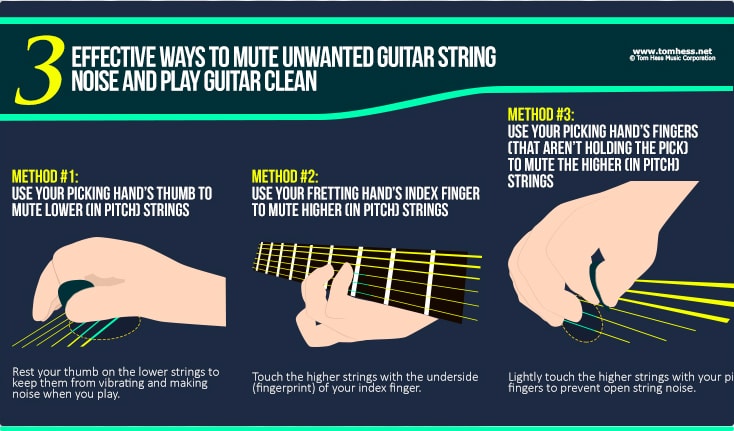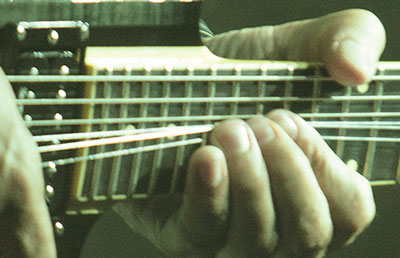Electric guitar strings are often easier to bend than acoustic guitar strings. They’re typically lighter and more pliable, facilitating easier string bending.
The art of string bending is essential in electric guitar playing, offering expressive vibrato and pitch variation which are quintessential to genres like blues and rock. Guitarists, both amateur and professional, appreciate the flexibility that electric guitars provide. The string gauge, material, and guitar setup all contribute to the ease of bending.
A lighter string gauge made of nickel-plated steel is standard for most electric guitars, which requires less finger strength to achieve the desired bend. Proper setup, including action and neck relief, also influences playability. Understanding these factors can optimize your electric guitar for those soulful bends and sustain that characterize so much of modern music.

Credit: tomhess.net
Introduction To Guitar Strings And Bending Technique
Welcome to the pulsating world of electric guitar playing, where the magic often lies in the deft fingers of the guitarist and the subtle art of string bending. Whether you’re a bewitched beginner or a seasoned strummer, understanding the nuances of your instrument’s strings can transform your playing from ordinary to extraordinary. Let’s dive headfirst into the Introduction to Guitar Strings and Bending Technique, a foundational pillar for expressive solos and emotive leads that can capture an audience’s heart.
Understanding Guitar String Mechanics
Guitar strings are essential elements that dictate the sound, playability, and responsiveness of your guitar. These slender threads of metal are precision-engineered to vibrate at specific frequencies, creating the melodious sounds we associate with our favorite tunes. Electric guitar strings, in particular, are often made from materials like nickel-plated steel, which offer a bright, clear tone conducive to a wide range of musical styles.
- Gauge: The gauge, or thickness of the strings, plays a pivotal role in their flexibility and tone. Lighter gauge strings are typically easier to manipulate and bend, making them a popular choice for genres that emphasize lead guitar techniques.
- Construction: Strings can be roundwound or flatwound, with roundwound offering a brighter sound and more textural feel under the fingers.
- Tension: Tension refers to the amount of force required to displace a string. Lower tension strings generally facilitate easier bending.
Grasping these basics provides a solid foundation for optimizing your guitar setup to suit your playing style and level up your string bending prowess.
The Basics Of String Bending
String bending is an expressive guitar technique that involves pushing or pulling a string across the guitar’s fretboard to raise its pitch. This technique allows for nuanced expression, mimicking the vocal-like qualities that can make a guitar solo truly sing. Here’s a rundown of the core principles that underlie the art of bending strings:
- Anchor Fingers: Use your fingers behind the bending finger as a fulcrum for better support and control.
- Hand Position: Ensure your thumb is positioned over the neck to serve as a pivot point.
- Practice: Start with half-step bends to get a feel for the tension and gradually move to full-step bends.
- Intonation: Perfect your ear by matching the bent note’s pitch to the same note on a different string.
Effective string bending is a blend of strength, finesse, and acute aural skills. Develop these in tandem and you’ll unlock the expressive potential of your electric guitar like never before.
Comparing Electric And Acoustic Guitar Strings
Every guitar player looks for ease of playability and the unique sound qualities that strings can provide. To understand why electric guitar strings are generally easier to bend than acoustic guitar strings, it’s critical to look at their physical properties, tension, gauge, and materials.
Physical Differences Between Electric And Acoustic Strings
The physical characteristics of electric and acoustic guitar strings play a pivotal role in playability. Electric guitar strings are typically made lighter, thinner, and sometimes with a lower string action, which contributes to a softer feel. In contrast, acoustic guitar strings are often heavier to produce more volume and resonance acoustically.
Tension And Gauge: How They Affect Playability
The tension and gauge of strings directly influence the force required to press and bend the strings. Electric guitars usually have strings with lighter gauge, resulting in lower tension and ultimately making bends and vibrato techniques more manageable. On the other hand, acoustic guitars have strings with heavier gauges, making them harder to bend due to higher tension.
Material And Coating: Impact On Bending Ease
Guitar string materials and coatings also substantially affect bending ease. Electric guitar strings often use nickel-plated steel or pure nickel, which are softer materials that facilitate smoother and easier bending. Additionally, some strings come with coatings that further reduce friction. Meanwhile, acoustic strings typically use bronze or phosphor bronze, which are harder materials that can resist bending more than their electric counterparts.
Factors Influencing The Ease Of Bending Electric Guitar Strings
Embarking on the quest to master electric guitar solos, you’ll soon discover that the ability to bend strings is a core element of expressive playing. The act of bending involves pushing or pulling the string along the fretboard to raise its pitch. Distinct factors determine how effortlessly you can achieve these bends, contributing greatly to the signature sound of guitar legends. Understanding these variables ensures that your journey in string bending is both successful and enjoyable.
String Gauge And Tension: Finding The Sweet Spot
The gauge of guitar strings plays a pivotal role in their ability to bend. Thinner strings, often labeled as light or super light, create less tension and are notably easier to bend than thicker, heavy gauge strings. Most guitarists find a medium gauge string to be the sweet spot, offering both ease in bending and a well-rounded tone.
- Light Gauge – Typically .008 to .042 inches in diameter; require less finger pressure to bend.
- Medium Gauge – Range around .009 to .046 inches; balance tone and flexibility.
- Heavy Gauge – Generally .010 to .052 inches or more; produce a fuller tone with more finger effort required for bending.
Scale Length And Its Role In String Bending
Scale length — the distance between the nut and the bridge of the guitar — influences the required tension for a note. Guitars with longer scale lengths such as Fenders require more tension for the same pitch compared to shorter scale guitars like Gibsons, resulting in a stiffer feel when bending. Comprehension of your instrument’s scale length enables you to account for the corresponding tension and adjust your playing technique accordingly.
Action And Setup: Making Bending Easier
Action, the distance between the strings and the fretboard, can heavily impact bending ease. Low action allows for smoother, easier bends with reduced finger fatigue. Conversely, high action demands more force to achieve a similar bend, potentially impacting playability. Regular guitar setups by a professional can optimize action, thus enhancing the bending experience. Components such as the bridge height, neck relief, and nut slots contribute to the overall action and playability of your electric guitar.
Player Technique And Finger Strength
Bending is not solely dependent on the instrument, as the player’s technique and finger strength play significant roles. Mastery of bending technique encompassing accurate pitch control and vibrato adds an emotional depth to solos and riffs. Developing finger strength through exercises and regular practice will result in controlled, confident bends without excessive strain. Embracing the nuances of string bending opens a realm of expressive possibilities on the electric guitar.

Credit: davidvstewart.com
Enhancing The Bending Experience On Electric Guitars
The enchanting allure of the perfect bend on an electric guitar can captivate both the player and the listener with its expressive potential. Enhancing the bending experience on electric guitars, through lighter string gauges, specialized tools, and adept technique, transforms the act into an art form. Crafting the ideal sound involves not just talent, but also a considered approach to the setup and maintenance of your instrument. Let’s dive into how an electric guitarist can finesse bending into a soul-stirring feature of their play.
Customizing String Gauges For Optimal Bending
The road to effortless bends starts with selecting the right string gauge. The gauge, or thickness, of strings has a profound effect on playability and bending ease. Lighter gauge strings, often recommended for bending, offer less resistance and require less finger strength, making them ideal for smooth, fluid bends. Here’s how you can select the best gauge:
- Extra Light Gauge: Typically .008-.038 inches — Easiest to bend, perfect for beginners or players with a lighter touch.
- Light Gauge: Around .009-.042 inches — Strikes a balance between playability and tone, favored by many seasoned players.
- Medium Gauge: Approximately .010-.046 inches — Offers more resistance, leading to a fuller sound, but requires more finger strength to bend.
Changing string gauge can affect guitar setup, so adjustments to the neck tension and intonation may be necessary to maintain optimal playability.
Using String Lubricants And Bending Aids
Bending strings should feel like a seamless extension of your musical expression. To achieve this, consider the role of string lubricants and bending aids. Lubricants reduce friction between the strings and your fingers, making bends smoother and more controlled. Here are some options:
- Finger-Ease: A spray that lightly coats the strings to reduce friction.
- Nut Sauce: A lubricant applied to the nut and bridge to enhance tuning stability and ease of bending.
- String Conditioners: Products designed to clean and lubricate strings, prolonging their life and improving playability.
Additionally, consider investing in quality string bending aids, such as a slide or a bend assist tool, especially if you aim to perform more extensive, controlled bends.
Practice Tips For Mastering The Art Of Bending
Excelling in string bending demands diligent practice. The journey to bending mastery includes:
- Pitch Recognition: Practice hitting the correct pitch consistently. Use a tuner to verify accuracy.
- Muscle Memory: Start with slow, deliberate bends to build muscle memory, then gradually increase speed.
- Variety in Bends: Experiment with half, full, and over-bends to develop a diverse bending style.
- Supporting Fingers: Use more than one finger to bend strings, distributing the pressure and increasing control.
Consistent practice leads to a more intimate understanding of your instrument’s response to your touch, allowing for bends that resonate with emotional impact.
Electric Guitars And Genre: Bending Across Music Styles
Welcome to the intersection of electric guitars and the diverse world of music genres, where the art of string bending resonates with unique flair across styles. Bending strings on an electric guitar is not just a technique—it’s an expressive tool that can communicate the deepest emotions of a song, accentuate solos, and define the musical signature of a genre. Let’s explore how this compelling method of playing has shaped different music styles and uncover the secrets behind the bends of guitar legends.
The Significance Of String Bending In Different Genres
String bending is an integral element that transcends genre boundaries, yet its application and subtlety vary based on musical context:
- In blues, bending is used to mimic the human voice, adding soulful expressions that elicit a strong emotional response.
- Rock music often employs aggressive and pronounced bends to convey energy and attitude within guitar solos.
- Country guitarists incorporate bends to emulate the sounds of the pedal steel guitar, creating a distinct twangy feel.
- In jazz, bends might be more subdued but are masterfully used to highlight nuances in the complex harmonic structure of the genre.
- Even in metal, bending takes on an aggressive form, contributing to the heavy and dark atmosphere of the music.
Iconic Bend Techniques Among Guitar Legends
Some guitarists are renowned for their bending techniques, leaving a permanent mark on the music industry:
| Guitarist | Technique | Genre |
|---|---|---|
| David Gilmour | Slow, emotive bends with sustained notes | Rock |
| B.B. King | Subtle vibrato bends | Blues |
| Albert Lee | Country-style twang bends | Country |
| Steve Vai | Extreme whammy bar and finger bends | Rock/Metal |
| Wes Montgomery | Sophisticated, jazzy bends | Jazz |
String Preferences Among Professional Guitarists
Professional guitarists often have specific preferences when it comes to strings, which can significantly affect their bending technique:
- Thinner gauge strings (e.g., .009-.042) are easier to bend and are favored by lead guitarists seeking flexibility and ease during solos.
- Heavier gauge strings (e.g., .011-.050) offer more resistance, which can lead to a richer, fuller tone but require more finger strength to bend.
- Some guitarists opt for a hybrid set-up with lighter strings on the high end and heavier strings on the low end to balance bendability with tone.
- String material also plays a role—nickel-plated strings are known for their warm tone and smooth bending properties.
- Coated strings can add longevity and reduce finger squeak, aiding in smoother bends and transitions.
Conclusion And Recommendations
Embarking on the journey to master the art of string bending on an electric guitar requires not only skill and practice but also the right set of strings that complement your playing style. The ease with which you can bend a string often boils down to personal comfort and the specific characteristics of the strings you choose. Here we’ll compile our distilled advice on selecting and maintaining guitar strings to help ensure every bend is as seamless and expressive as you intend it to be.
Choosing The Right Strings For Your Style And Comfort
Finding the perfect strings is a personal quest for every guitarist. To assist in making an informed decision, consider the following:
- Gauge: Lighter gauge strings are typically easier to bend due to their reduced tension.
- Material: Nickel-plated steel strings are known for their balance between warmth and brightness, making them a versatile choice.
- String Core: A hex core may offer more tension than a round core, impacting bendability.
Testing different strings can vastly improve playability. It’s essential to match your string choice to your music genre, playing technique, and individual comfort. For example, blues players often opt for lighter strings to execute fluid bends, while rock guitarists might prioritize heavier strings for a thicker tone, despite them being slightly tougher to bend.
Maintaining Strings For Longevity And Optimal Bending
Maintaining your strings is just as important as selecting the right type. To ensure your strings remain supple and responsive, follow these tips:
- Clean your strings after every session to remove oils and dirt.
- Use a string conditioner for smoother bends and extended string life.
- Re-string regularly before the strings lose their resilience and tone.
Remember, old and worn-out strings not only sound dull but are also more challenging to bend. They can break easily, potentially disrupting your performance or practice session. Keeping your strings in prime condition will ensure that every bend is precise and effortless.

Credit: www.fachords.com
Do Changing Electric Guitar Strings Affect Their Bendability?
Changing electric guitar strings can significantly affect their bendability. Fresh strings often provide better tension and responsiveness, making bends smoother and more precise. Musicians should consider how frequently to restring guitars, as older strings can lose their elasticity, impacting playability and overall sound quality. Regular maintenance ensures optimal performance.
Frequently Asked Questions On Are Electric Guitar Strings Easier To Bend
What Are The Easiest Guitar Strings To Bend?
Lighter gauge guitar strings are easier to bend. Nickel-plated steel strings offer a smoother bending experience. Popular choices include 9-42 gauge or even 8-38 for ultra-light action.
Are The Strings Of The Electric Guitar Easier To Play?
Electric guitar strings are often considered easier to play due to their lighter gauge and lower action, which require less finger pressure.
Why Is The E String Hard To Bend?
The E string is harder to bend because it is thicker and under more tension than the other strings, requiring more finger strength.
Why Are Acoustic Guitar Strings Harder To Bend?
Acoustic guitar strings are harder to bend due to their thicker gauge and higher tension compared to electric guitar strings. This design supports the acoustic’s need for a louder, clearer sound without amplification.
Conclusion
Experimenting with electric guitar strings can unlock new creative possibilities. Whether you’re a seasoned player or a beginner, the ease of bending notes is undeniable. So embrace the flexibility of electric guitar strings and feel the music flow through your fingertips.
Keep rocking and expressing your musical soul!
{ “@context”: “https://schema.org”, “@type”: “FAQPage”, “mainEntity”: [ { “@type”: “Question”, “name”: “What are the easiest guitar strings to bend?”, “acceptedAnswer”: { “@type”: “Answer”, “text”: “Lighter gauge guitar strings are easier to bend. Nickel-plated steel strings offer a smoother bending experience. Popular choices include 9-42 gauge or even 8-38 for ultra-light action.” } } , { “@type”: “Question”, “name”: “Are the strings of the electric guitar easier to play?”, “acceptedAnswer”: { “@type”: “Answer”, “text”: “Electric guitar strings are often considered easier to play due to their lighter gauge and lower action, which require less finger pressure.” } } , { “@type”: “Question”, “name”: “Why is the E string hard to bend?”, “acceptedAnswer”: { “@type”: “Answer”, “text”: “The E string is harder to bend because it is thicker and under more tension than the other strings, requiring more finger strength.” } } , { “@type”: “Question”, “name”: “Why are acoustic guitar strings harder to bend?”, “acceptedAnswer”: { “@type”: “Answer”, “text”: “Acoustic guitar strings are harder to bend due to their thicker gauge and higher tension compared to electric guitar strings. This design supports the acoustic’s need for a louder, clearer sound without amplification.” } } ] }
